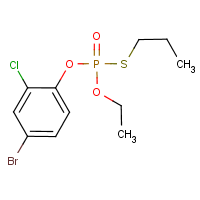Profenofos
Agent Name
Profenofos
CAS Number
41198-08-7
Formula
C11-H15-Br-Cl-O3-P-S
Major Category
Pesticides

Synonyms
CGA 15324; Curacron; O-(4-Bromo-2-chlorophenyl)-O-ethyl-S-propyl phosphorothioate; Phosphorothioic acid, O-(4-bromo-2-chlorophenyl) O-ethyl S-propyl ester (9CI); Phosphorothioic acid, O-(4-bromo-2-chlorophenyl)-O-ethyl S-propyl ester; Polycron; Selecron; [ChemIDplus]
Category
Organophosphate Insecticides
Description
Pale yellow or amber liquid with an odor like garlic; [HSDB]
Sources/Uses
Used as insecticide and acaricide for cotton and vegetables; [Merck Index] Only used on cotton in the US; [Reference #1]
Comments
A human cholinesterase inhibitor; Caused morphological changes and decrease in count and motility to mice sperm after five days of dosing; Liver function affected by acute and sub-chronic dosing in rabbits based on enzyme testing; [HSDB] Lower ratio of symptomatic human poisoning cases reported per pound of usage than other cholinesterase inhibiting pesticides; [Reference #1] “The average of two baseline respective cholinesterase activity determinations three days apart, with no exposures to enzyme inhibiting pesticides for at least 30 days, is recommended for each worker prior to exposure to cholinesterase inhibitors because of large inter-individual differences in published baseline values. To be established at least once a year. Removal from workplace exposures is recommended until the cholinesterase activity returns to within 20% of baseline.” [TLVs and BEIs]
Restricted
A restricted use pesticide in the US; [Reference #1]
Reference Link #1
Biomedical References
Exposure Assessment
BEI
Acetylcholinesterase activity in red blood cells = 70% of individual's baseline; Butylcholinesterase activity in serum or plasma = 60% of individual's baseline; Sample at end of shift; [TLVs and BEIs]
Vapor Pressure
9E-07 mm Hg
Lethal Concentration
LC50 (rat) = 3,000 mg/m3/4h
Reference Link #2
Adverse Effects
Hepatotoxin
Hepatoxic (a) from occupational exposure (secondary effect) or (b) in animal studies or in humans after ingestion
Other Poison
Organophosphate
Diseases, Processes, and Activities Linked to This Agent
Diseases
Occupational diseases associated with exposure to this agent:
Processes
Industrial Processes with risk of exposure: